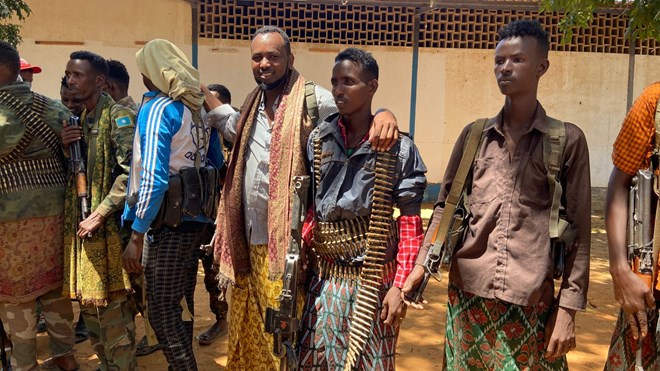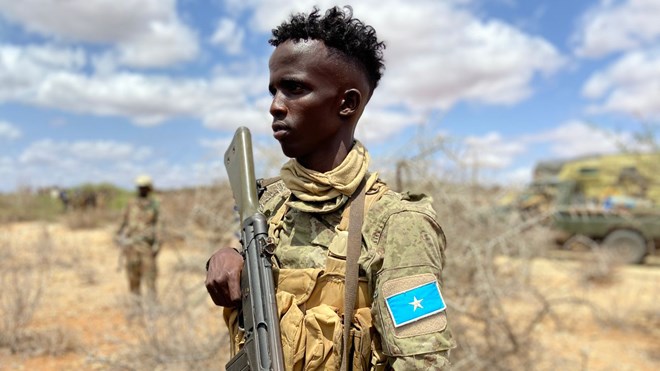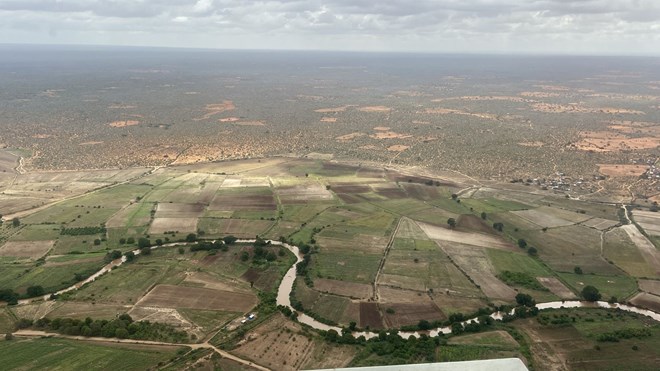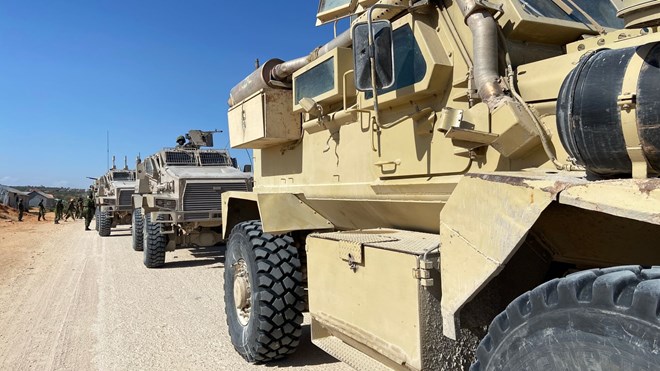
Thursday October 13, 2022
By Yousra Elbagir
In the latest of a 16-year effort to eradicate the al Qaeda-linked terror group al Shabaab, a new militia of farmers become the first line of defence in the battle for Somalia's stability.

The Ma'awisley fighters
Deep in the Buloburde bush in the Hiiraan region of central Somalia, there's a ragtag regiment gathering around a missile launcher.
Huddled tightly with their ears pressed against a small black phone, they receive intelligence and feed it back to the troops positioning the launcher.
The Ma'awisley militia is made up of farmers turned fighters and is in the front line of the battle for Somalia's stability. It is the new weapon of choice in the 16-year effort to eradicate al Shabaab, the terrorist group linked to al Qaeda.
This war is one without a conventional front line. Instead, there are territories around the country where al Shabaab entrench themselves in the community and frequently launch attacks.
Now, these communities are rising up against them.
"We are fighting for the right cause, for the people, for this nation and for the faith until Somalia is peaceful," says Ma'awisley commander Ali Shiri in Bal'ad - another hotspot just an hour outside the capital Mogadishu.
Primarily, they are protecting their families and farms. The lands they have long harvested are now parched by prolonged drought and stalked by al Shabaab fighters seeking money and food.
"They are bothering the community. We are farmers and they keep coming back to collect taxes from us. That is what made us fight," says Ali.
'Total war against al Shabaab' top of the president's agenda

The Ma'awisley fighters
This new push comes with a new administration, adamant to rid the country of insurgents. In May, President Hassan Sheikh Mohamud came into power and weeks later, a 30-hour siege of the Hayat Hotel in Mogadishu ended with the killing of 20 people. In response to the massacre, he declared a "total war against al Shabaab".
President Mohamud has survived two al Shabaab assassination attempts and his nephew was killed by the terror group in 2015. This is his second term as president and the fight against al Shabaab continues to be at the top of his agenda.
Today, some of the fiercest battles are taking place in his home region of Hiraan where his government is steadily recruiting farmers to fight, a task made easier by the harsh climate conditions.
"We are facing the worst drought here in Hiraan. There's been no rain and now we have an extra issue - war," says the governor of Hiraan and army veteran Ali Jeyte.
He has been fighting alongside the Ma'awisley for the past four months and says: "We are their leaders and we have told them what's good for them and they accept it."
The Ma'awisley are named after the bright wrap-around skirts they wear to work on their farm. Today, these same skirts are wrapped around military fatigues and adorned with rows of new brass bullets supplied by the state. On their backs are rusty weapons bought on the black market.

A soldier from the Somali National Army stands watch as missiles are fired on al Shabaab locations
Fortified by ground support from the Somali National Army and heavy artillery provided by the African Transition Mission in Somalia (ATMIS), they are engaged in an all-out offensive in the battle of Hiraan.
"Around 300 to 400 militia men are surrounding al Shabaab at the moment," says Abdelsalam Mualim Mohamed, the Ma'awisley militia commander in Bulobarde.
Using their intelligence, ATMIS Djiboutian force commander Colonel Hassan Djama Farah prepares his men to launch the missiles. The first strike hits near the target and they fire another.
When the dust settles, the soldiers pack their guns on to the back of their trucks and the Ma'awisley once again blend into the bushes.
'Bombs are their weapon of choice', hitting morale as well as injuring soldiers
The government claims to have killed 200 al Shabaab fighters in the past few days alone and says that many have surrendered.
These numbers are difficult to verify in a war that has been characterised by conflicting information from both sides. The government has recently tightened laws restricting local reporting on the terrorist group and suspended some of their social media accounts. Many Somali journalists complain that that is media censorship.
In this ever-changing climate, al Shabaab is constantly changing its tactics.
“We train on them, they train on us,” says Brigadier General Keith Katunji. He’s the commander of ATMIS Ugandan troops and has been stationed in Somalia on and off since 2010.
His sector is Lower Shabelle, home to Mogadishu and where close to half of the country's population live.
Shabelle River, Somalia, which runs through the lower Shabelle region, where commander of ATMIS Ugandan troops is stationed
"The improvised explosive devices (IEDs) or bombs are al Shabaab’s weapon of choice. They know we supply our bases by road so they concentrate on putting IEDs on the road and that affects us psychologically," he says.
It’s the injuries sustained from these bombs that affect his soldiers' morale, but still they take on the daily task of painstakingly clearing a major road linking Mogadishu to central Somalia, a critical artery supplying the country with food and fuel.
The Uganda People's Defence Force (UPDF) finds five to six improvised explosive devices on the 150-mile road every day, searching it inch by inch.
Lush farms become drought-ravaged lands as food security destroyed
"The United Nations and the government are trying to supply foodstuff so we have to do this kind of operation. You have to go and pacify the area where food will be dumped and give people hope," says the brigadier.
Four failed rainy seasons have destroyed food security across the country and forecasts suggest there is unlikely to bring the moisture needed to replenish agricultural land.Lower Shabelle is technically the most fertile part of Somalia. But from above, formerly lush farms have become drought-ravaged lands. Now littered with planted bombs instead of fields of crops.
Just under seven million people are at risk of starvation - close to half of the country's population.

Abdelsalam Mualim Mohamed, a Ma'awisley fighter, in the Hiraan region of Somalia
"A hungry man is an angry man,' adds brigadier Katunji.
This anger is building amongst the Ma'awisley who are not just facing drought.
"When it is harvest time, al Shabaab comes and says we have to pay - these are the challenges we are facing," says commander Ali Shiri in Bal'ad, a city in Middle Shabelle where another offensive is underway.
Bal'ad is close to al-Shabaab's former capital Basra and where the terror group would hold Sharia courts to settle issues like land disputes.
For Bal'ad's mayor Qaasim Furdug this fight is deeply personal. He lost his leg in 2010 in Mogadishu in a battle against al Shabaab and insists the war against them continues.
A fight that rural communities - once terrorised into silence - are now at the forefront.
'Either farm as a free man or die - we are facing bullets'
"People thought al Shabaab were on the right path but now they have become aware that al Shabaab are the true enemy," says mayor Furdug.
"So everyone decided to either farm as a free man or die. We are facing bullets. We are facing our enemy."
The Mayor is greeted by Ma'awisley fighters as he leaves his office. They are taking a break before heading back out to confront al Shabaab.
These battles are breaking out all across the country as the government pushes to reclaim territory - another symptom of Somalia's increasingly uninhabitable environment.
“We can't farm and as farmers, we are ready to defend our land and people,” says Ma'awisley fighter Abdi Mahmoud Hussein in Bal'ad town.
At least half of the seven million Somalis affected by the drought are estimated to live in the al Shabaab-controlled territory, a curse many believe goes hand in hand.
"There is a lack of rain and wherever al Shabaab goes, drought follows," Abdi adds. 
A convoy of the Uganda People's Defence Force, part of the African Union Transition Mission in Somalia, outside Mogadishu